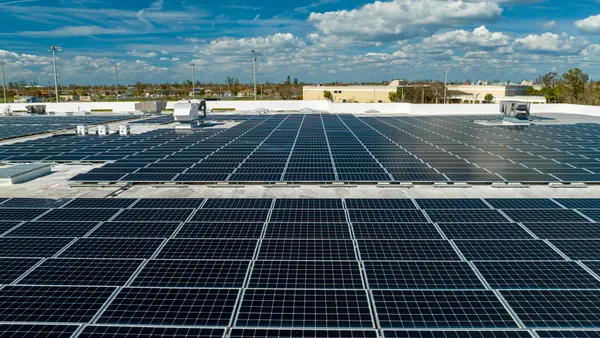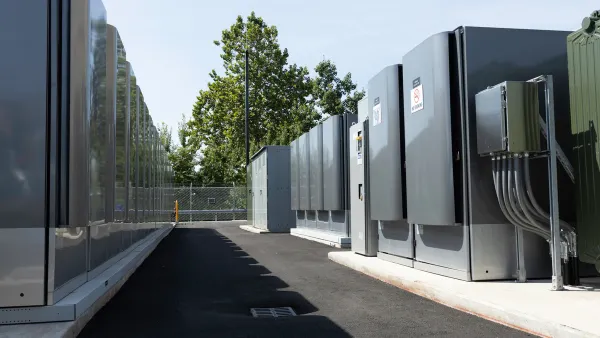Dive Brief:
- The New York Public Service Commission (PSC) on Thursday directed the state's energy development authority to offer additional financial options beyond traditional fixed-price contracts when soliciting bids to build renewable energy projects.
- The move is expected to reduce risks for renewable project developers, decrease financing costs, and attract new projects, investment and competition.
- The PSC yesterday also directed nearly $2 billion in utility spending on energy efficiency and building electrification initiatives.
Dive Insight:
The PSC sees its order to the New York State Energy Research and Development Authority (NYSERDA) as a means "to decrease capital costs and further spur the development of ... clean energy resources."
The move builds on Democratic Gov. Andrew Cuomo's Jan. 8 announcement, in his 2020 State of the State address, that NYSERDA would make competitive awards to 21 large-scale wind, solar and storage projects in upstate New York, totaling more than 1 GW of capacity, the PSC noted.
According to the PSC, over 2,700 MW of solar, wind and storage capacity has been installed in the state since 2011, with another 7,000 MW in development. In 2019, New York passed the Climate Leadership and Community Protection Act requiring a zero-carbon electricity sector by 2040.
The PSC's "decision today will benefit renewable energy developers by reducing their risks while also lowering customer costs," Commission Chair John B. Rhodes said in a statement.
Renewable energy developers in New York receive revenue from the state's energy and capacity markets as well as from the renewable energy credits (RECs) a project generates, Ryan Katofsky, managing director at Advanced Energy Economy, told Utility Dive. Those RECs are the mechanism for complying with New York's Clean Energy Standard.
But while energy and capacity market prices can go up and down, REC prices in New York are currently fixed when developers bid for projects through NYSERDA, the state agency responsible for centralized procurement of RECs.
The difference with the new order is that instead of staying fixed, the indexed REC price will go up or down, depending on the direction of prices in the energy and capacity markets, to ensure there's a consistent amount of revenue for developers and projects always get what they need, Katofsky explained.
The key benefit is that developers have less risk, which lowers financing costs, thus lowering total costs for renewable energy projects, Katofsky said.
To arrive at the $4.6 billion savings estimate, NYSERDA took a previous estimate that 29,200 GWh of new renewable energy output a year would be needed to meet New York's mandate that 50% of its electricity production come from renewable resources by 2030. It then used a per REC savings value of $8 per MWh, projecting it would lead to about $233 million in savings a year through 2030 and about $4.6 billion over the life of the contracts, the PSC decision noted.
"NYSERDA indicated that using an Index REC would likely expand the pool of bidders in future procurements, providing a boost to competition and likely additional downward pricing pressure on REC bids," the decision continued.
"A similar indexed REC product is already operating with similar rules for offshore wind projects in New York, so much of the implementation has already been figured out," Katofsky noted in a separate email.
The PSC's decision responds to a petition filed by the Alliance for Clean Energy New York (ACENY) and the American Wind Energy Association.
Anne Reynolds, executive director of ACENY, said in a statement, the new contracting option "will attract new projects, investment, and competition to New York."
Separately, the PSC on Thursday directed almost $2 billion in utility energy efficiency and building electrification actions. The PSC "has approved an ambitious set of energy efficiency and electric heat pump targets to dramatically reduce energy consumption in New York," the commission noted in a press release.
The total includes $893 million for electric energy efficiency, $553 million for gas energy efficiency and $454 million for heat pumps through 2025, the PSC noted.
In addition, "the commission re-authorized funding to support existing levels of utility energy efficiency activities through 2025 totaling $1.3 billion, meaning today's decision will result in a new total of over $3 billion in investor-owned utility investments for energy-efficiency and building electrification through 2025," the commission added.
A wide range of environmental groups praised the energy efficiency provisions, with Lisa Dix, Sierra Club's Senior New York campaigns manager calling it "the state's most cost-effective step in meeting its ambitious climate goals while saving New Yorkers money on their energy bills, and creating family-wage jobs in New York's clean energy economy."













